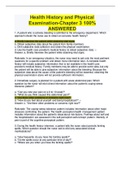Exam (elaborations)
Health History and Physical Examination-Chapter 3 100% ANSWERED
- Course
- Institution
MULTIPLE CHOICE Question: A patient who is actively bleeding is admitted to the emergency department. Which approach is best for the nurse to use to obtain a health history? Question: During the health history interview, a patient tells the nurse about periodic fainting spells. Which question b...
[Show more]



